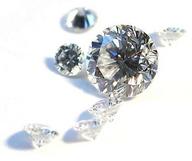Subject

photo credits: Wikimedia Commons
Diamond is one of the best-known and most sought-after gemstones. They have been used as decorative items since ancient times. The hardness of diamond and its high dispersion of light — giving the diamond its characteristic "fire" — make it useful for industrial applications and desirable as jewelry. Diamonds are such a highly traded commodity that multiple organizations have been created for grading and certifying them based on the "four Cs", which are color, cut, clarity, and carat. Other characteristics, such as presence or lack of fluorescence, also affect the desirability and thus the value of a diamond used for jewelry. Diamonds are used in engagement rings. The practice is documented among European aristocracy as early as the 15th century, though ruby and sapphire were more desirable gemstones. The modern popularity of diamonds was largely created by De Beers Consolidated Mines, which established the first large-scale diamond mines in South Africa. Through an advertising campaign beginning in the 1930s and continuing into the mid-20th century, De Beers made diamonds into a key part of the betrothal process and a coveted symbol of status. The diamond's high value has been the driving force behind dictators and revolutionary entities, especially in Africa, using slave and child labor to mine blood diamonds to fund conflicts. Though popularly believed to derive its value from its rarity, gem-quality diamonds are quite common compared to rare gemstones such as alexandrite, and annual global rough diamond production is estimated to be about 130 million carats (26 tonnes; 29 short tons). Source: Wikipedia (en)
Works about diamond 1
Subject - wd:Q17413599